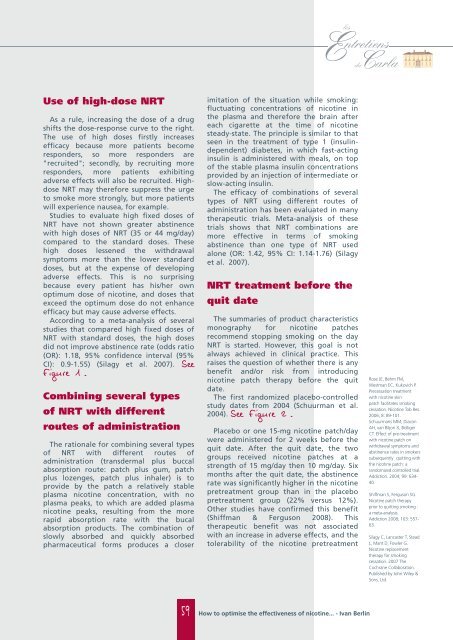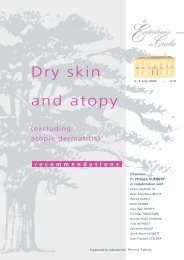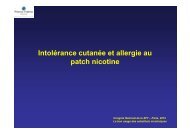Nicotine replacement therapy … - Carlos A ... - Entretiens du Carla
Nicotine replacement therapy … - Carlos A ... - Entretiens du Carla
Nicotine replacement therapy … - Carlos A ... - Entretiens du Carla
You also want an ePaper? Increase the reach of your titles
YUMPU automatically turns print PDFs into web optimized ePapers that Google loves.
Use of high-dose NRT<br />
As a rule, increasing the dose of a drug<br />
shifts the dose-response curve to the right.<br />
The use of high doses firstly increases<br />
efficacy because more patients become<br />
responders, so more responders are<br />
"recruited"; secondly, by recruiting more<br />
responders, more patients exhibiting<br />
adverse effects will also be recruited. Highdose<br />
NRT may therefore suppress the urge<br />
to smoke more strongly, but more patients<br />
will experience nausea, for example.<br />
Studies to evaluate high fixed doses of<br />
NRT have not shown greater abstinence<br />
with high doses of NRT (35 or 44 mg/day)<br />
compared to the standard doses. These<br />
high doses lessened the withdrawal<br />
symptoms more than the lower standard<br />
doses, but at the expense of developing<br />
adverse effects. This is no surprising<br />
because every patient has his/her own<br />
optimum dose of nicotine, and doses that<br />
exceed the optimum dose do not enhance<br />
efficacy but may cause adverse effects.<br />
According to a meta-analysis of several<br />
studies that compared high fixed doses of<br />
NRT with standard doses, the high doses<br />
did not improve abstinence rate (odds ratio<br />
(OR): 1.18, 95% confidence interval (95%<br />
CI): 0.9-1.55) (Silagy et al. 2007). See<br />
Figure 1.<br />
Combining several types<br />
of NRT with different<br />
routes of administration<br />
The rationale for combining several types<br />
of NRT with different routes of<br />
administration (transdermal plus buccal<br />
absorption route: patch plus gum, patch<br />
plus lozenges, patch plus inhaler) is to<br />
provide by the patch a relatively stable<br />
plasma nicotine concentration, with no<br />
plasma peaks, to which are added plasma<br />
nicotine peaks, resulting from the more<br />
rapid absorption rate with the bucal<br />
absorption pro<strong>du</strong>cts. The combination of<br />
slowly absorbed and quickly absorbed<br />
pharmaceutical forms pro<strong>du</strong>ces a closer<br />
imitation of the situation while smoking:<br />
fluctuating concentrations of nicotine in<br />
the plasma and therefore the brain after<br />
each cigarette at the time of nicotine<br />
steady-state. The principle is similar to that<br />
seen in the treatment of type 1 (insulindependent)<br />
diabetes, in which fast-acting<br />
insulin is administered with meals, on top<br />
of the stable plasma insulin concentrations<br />
provided by an injection of intermediate or<br />
slow-acting insulin.<br />
The efficacy of combinations of several<br />
types of NRT using different routes of<br />
administration has been evaluated in many<br />
therapeutic trials. Meta-analysis of these<br />
trials shows that NRT combinations are<br />
more effective in terms of smoking<br />
abstinence than one type of NRT used<br />
alone (OR: 1.42, 95% CI: 1.14-1.76) (Silagy<br />
et al. 2007).<br />
NRT treatment before the<br />
quit date<br />
The summaries of pro<strong>du</strong>ct characteristics<br />
monography for nicotine patches<br />
recommend stopping smoking on the day<br />
NRT is started. However, this goal is not<br />
always achieved in clinical practice. This<br />
raises the question of whether there is any<br />
benefit and/or risk from intro<strong>du</strong>cing<br />
nicotine patch <strong>therapy</strong> before the quit<br />
date.<br />
The first randomized placebo-controlled<br />
study dates from 2004 (Schuurman et al.<br />
2004). See Figure 2.<br />
Placebo or one 15-mg nicotine patch/day<br />
were administered for 2 weeks before the<br />
quit date. After the quit date, the two<br />
groups received nicotine patches at a<br />
strength of 15 mg/day then 10 mg/day. Six<br />
months after the quit date, the abstinence<br />
rate was significantly higher in the nicotine<br />
pretreatment group than in the placebo<br />
pretreatment group (22% versus 12%).<br />
Other studies have confirmed this benefit<br />
(Shiffman & Ferguson 2008). This<br />
therapeutic benefit was not associated<br />
with an increase in adverse effects, and the<br />
tolerability of the nicotine pretreatment<br />
59 How to optimise the effectiveness of nicotine... - Ivan Berlin<br />
Rose JE, Behm FM,<br />
Westman EC, Kukovich P.<br />
Precessation treatment<br />
with nicotine skin<br />
patch facilitates smoking<br />
cessation. <strong>Nicotine</strong> Tob Res.<br />
2006; 8: 89-101.<br />
Schuurmans MM, Diacon<br />
AH, van Biljon X, Bolliger<br />
CT. Effect of pre-treatment<br />
with nicotine patch on<br />
withdrawal symptoms and<br />
abstinence rates in smokers<br />
subsequently quitting with<br />
the nicotine patch: a<br />
randomized controlled trial.<br />
Addiction. 2004; 99: 634-<br />
40.<br />
Shiffman S, Ferguson SG.<br />
<strong>Nicotine</strong> patch <strong>therapy</strong><br />
prior to quitting smoking :<br />
a meta-analysis.<br />
Addiction 2008; 103: 557-<br />
63.<br />
Silagy C, Lancaster T, Stead<br />
L, Mant D, Fowler G.<br />
<strong>Nicotine</strong> <strong>replacement</strong><br />
<strong>therapy</strong> for smoking<br />
cessation. 2007 The<br />
Cochrane Collaboration.<br />
Published by John Wiley &<br />
Sons, Ltd.






